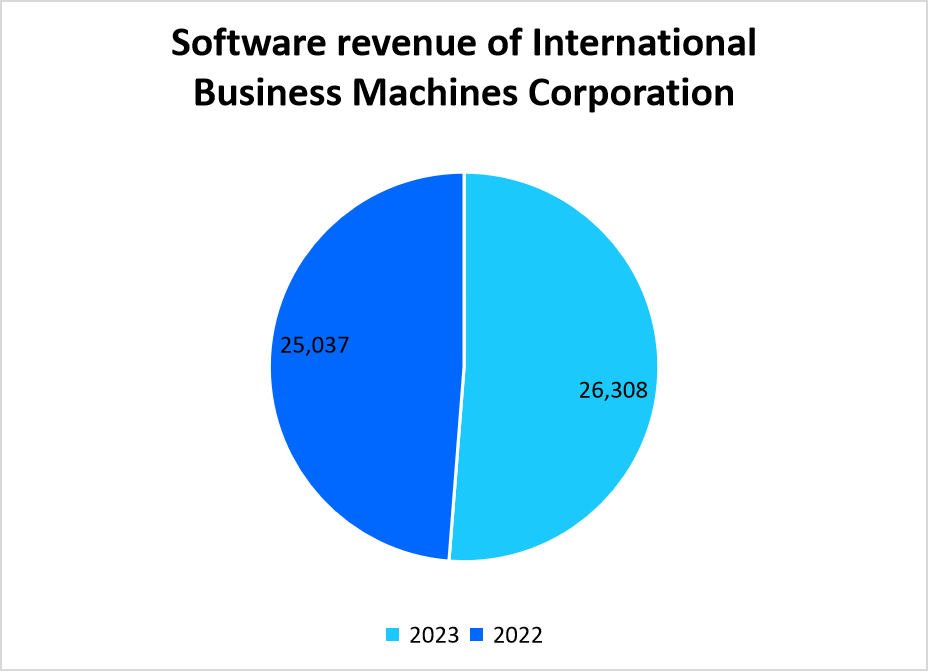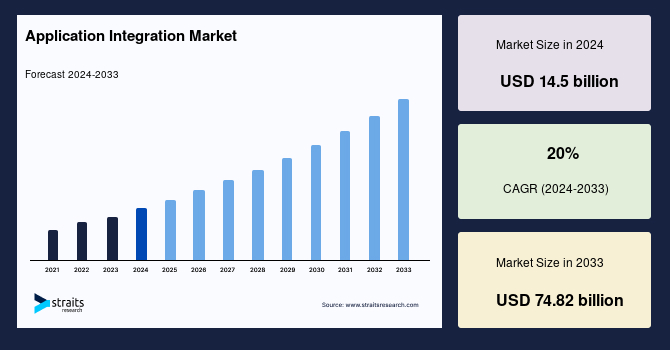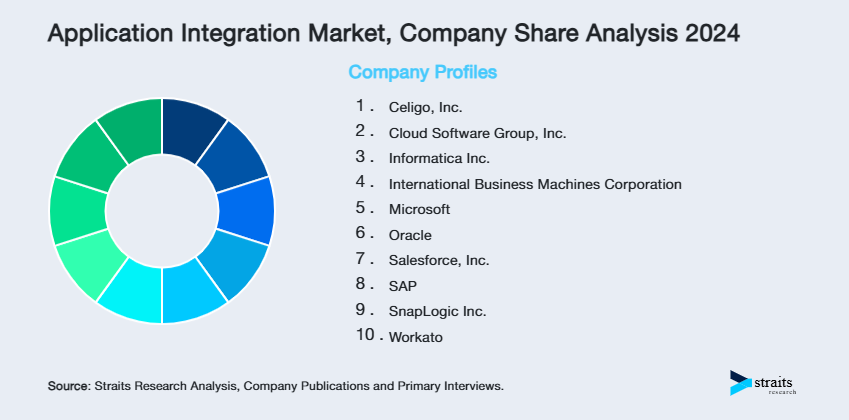Application Integration Market Size
The global application integration market size was worth USD 14.5 billion in 2024 and is estimated to reach an expected value of USD 17.4 billion in 2025 to USD 74.82 billion by 2033, growing at a CAGR of 20% during the forecast period (2025-2033).
Application integration connects different software applications and systems seamlessly, enabling data exchange and coordinated functionality. It ensures that independent applications share data and workflows, reducing silos and improving operational efficiency. Integration can be achieved using APIs, middleware, cloud platforms, or custom solutions to synchronize processes across various business systems like customer relationship management (CRM), enterprise resource planning (ERP), and e-commerce platforms. Effective application integration enhances decision-making, automates processes, and improves customer experiences.
The global application integration industry is about technologies and solutions enabling diverse software applications to function cohesively within increasingly complex IT environments. With the growing adoption of cloud computing, IoT, big data, and digital transformation initiatives, organizations face the challenge of integrating disparate systems and platforms. Integration application solutions help satisfy this need by facilitating real-time data exchange and workflows and allowing seamless communications between on-premises, cloud-based, or hybrid infrastructures. They keep the data synced and automate processes to avoid operational inefficiencies and reduce downtime.
Furthermore, key market elements are the iPaaS, ESB, and API management tools to fill gaps between legacy and modern applications. The most important sectors employing these solutions involve BFSI, healthcare, retail, and manufacturing industries, wherein operations can be optimized and improved customer experiences are maintained. As businesses embrace trends like microservices, hybrid models, and AI-driven automation, the market is expected to witness significant growth.
The below depicts the software revenue of International Business Machines Corporation (IBM) for 2023 and 2022. The revenue for 2023 is $26,308 million, slightly higher than the 2022 revenue of $25,037 million, reflecting growth in this segment.

Source: Straits Research
Latest Market Trends
Hybrid Integration Platforms (hips)
Hybrid Integration Platforms represent the integration necessary for organizations wishing to combine traditional, on-premises systems with newer cloud-based applications and technologies. These hybrid platforms can be used by businesses to provide an easy method of connecting dissimilar systems across a legacy infrastructure and new cloud solutions. This hybrid platform offers support for platforms ranging from B2B systems and interactions with partners and suppliers to B2C customer engagement, BYOD mobile solutions, and big data applications.
- For instance, according to MuleSoft, Hybrid integration brings together the divides of your already existing enterprise or your databases, warehouses, applications, and legacy systems and SaaS/PaaS, B2B (partners & suppliers), B2C (customer engagement), BYOD (enterprise mobile), and big data.
Digital Transformation and Integration
As digital transformation continues to take shape in each industry, business processes, technologies, and systems integration are now extremely important. Due to the constant changes in this market landscape, businesses use the cloud-native for agility, scale, and innovative responses. Through this trend, AI, automation, and analytics in real-time are seen at the core of this transformation - enabling organizations to make more and more data-informed decisions.
- For instance, according to Splunk, 75% of leaders project full integration by 2025 as digital transformation increases. AI, automation, and real-time analytics will drive agility and scalability and empower organizations to innovate to meet the increasingly changing market requirements through cloud-native technologies.

To get more insights about this report Download Free Sample Report
Global Application Integration Market Growth Factors
Rise of Generative Ai (genai) in Application Integration
Major growth factors in the market include increased adoption of generative artificial intelligence (GenAI) technologies. Businesses must strengthen their existing systems and workflows with AI capabilities by demanding robust solutions for application integration, ensuring the smooth interoperability of disparate software applications, cloud platforms, and AI models. Integrating GenAI-driven systems into production environments demands high levels of automation, data processing, and real-time decision-making, all of which require effective strategies.
- For instance, by 2026, more than 80% of enterprises will have used generative artificial intelligence (GenAI) application programming interfaces (APIs) or models and/or deployed GenAI-enabled applications in production environments, up from less than 5% in 2023 as per industry analysts.
Adoption of Cloud Computing and Saas Solutions
Growing demand for cloud computing and Software-as-a-Service (SaaS) solutions are major drivers in the market. With cloud computing, an organization can scale its infrastructure rapidly. In contrast, SaaS-based software solutions allow companies to access various subscription-based flexible options, negating the requirement for on-premises installations. As business organizations increasingly look at cloud-first strategies, they must integrate several applications and data sources, hosted either on-premises or in the cloud, to ensure their operations run smoothly.
- For instance, industry analysts predict that over 85% of all organizations will adhere to a cloud-first principle by 2025, and 95% of all new digital workloads will be deployed on cloud-native platforms. Advanced application integration solutions are poised to play an ever more pivotal role in allowing smooth digital transformation.
Market Restraint
Operational Burden of Managing Api Changes and Broken Integrations
One of the significant challenges within the global market is the operational burden associated with managing API changes and broken integrations. As organizations increasingly rely on interconnected applications, maintaining seamless integrations becomes a complex and ongoing challenge. Since applications are frequently updated, businesses must continually monitor, adjust, and adapt their integrations to stay aligned with new software versions and evolving API structures.
Engineers must constantly track API deprecations, version updates, and feature discontinuations to ensure that integrations do not break. When an API version is updated or deprecated, companies must quickly modify their systems to accommodate these changes, often requiring significant time and engineering resources. If an integration fails, it can disrupt business operations, affect data flow, and even lead to compliance issues in industries like healthcare and finance.
- For instance, according to Merge, 50% of organizations struggle with maintaining integrations due to discontinued applications or features. Engineers must continuously monitor APIs, adapt to version changes, repair broken integrations, and communicate errors efficiently to mitigate disruptions. This creates a substantial operational and resource burden, often diverting attention from core business functions.
Market Opportunity
Financial Services Automation
The growing digital transformation in the financial services industry creates massive opportunities for the market. The sector depends on seamless communication between legacy banking systems, FinTech platforms, cloud services, and third-party applications, making integration solutions critical for improving efficiency, security, and customer experience.
Financial institutions can automate key processes through advanced API-based integrations and middleware platforms, including fraud detection, credit scoring, loan processing, and investment management. By integrating legacy systems with modern FinTech solutions, banks and financial institutions reduce manual intervention, enhance operational efficiency, and lower costs.
- For example, JP Morgan Chase has implemented API-driven automation, enabling integration between internal banking systems and external FinTech platforms. This integration has led to more advanced fraud detection, real-time credit scoring, and dynamic investment management, giving the company a competitive edge.
Additionally, the rise of Open Banking initiatives worldwide accelerates the adoption of secure API-driven integration. Countries like the UK, Australia, and Singapore have introduced regulations mandating financial institutions provide API-based access to customer data, further fueling market demand for robust solutions.
Regional Insights
North America: Dominant Region with A Significant Market Share
North America dominates the global application integration market due to the high adoption of cloud-based and SaaS applications. This region boasts a strong technological infrastructure, allowing the widespread use of multiple cloud and on-premises systems in various industries. As more organizations rely on different applications to streamline their operations, there is an increased need for integration solutions.
- For instance, in 2023, the average organization globally utilized 112 SaaS applications. Between 2015 and 2023, the number of SaaS applications used by companies grew steadily, mainly driven by the pre-pandemic software boom that fueled rapid growth and spending.
Asia Pacific: Rapidly Growing Region
Asia Pacific is one of the fastest-growing regions in the global application integration market because of its rapidly accelerating digital transformation and widespread use of cloud technology. Several emerging economies in the region are investing more in digital infrastructure for business growth, improved operational efficiencies, and better customer experiences. As manufacturing, retail, healthcare, and finance businesses expand their digital operations, seamless application integration solutions connect cloud-based platforms and on-premises systems.
- For instance, integrating ERP, CRM, and manufacturing execution systems (MES) is critical for achieving the goals outlined in the Made in China 2025 strategy. Under the Digital India program, initiatives like BharatNet (connecting rural areas with broadband) and e-Kranti (government e-services)
Countries Insights
- United States: The U.S. is leading digital transformation efforts, with businesses investing heavily in cloud computing, AI, and automation. Application integration enables organizations to seamlessly link new tools with existing enterprise systems, ensuring efficient data management and better decision-making. The need for secure, scalable, real-time integration solutions is exceptionally high in the finance, healthcare, and retail sectors.
- Japan: Japan’s rapid adoption of cloud computing and AI has increased the need for hybrid integration solutions. Businesses require application integration to support connectivity across on-premises and cloud environments, enabling seamless interactions between AI, IoT, and machine learning applications. The manufacturing and automotive industries are also driving demand for integration solutions to enhance smart factory operations.
- China: China’s booming cloud computing sector fuels demand for integration solutions that bridge cloud and on-premises systems. The widespread implementation of AI, IoT, and blockchain technologies in financial services, manufacturing, and healthcare necessitates strong interoperability and real-time data synchronization, making application integration crucial for business scalability and efficiency.
- Germany: Germany's focus on innovation and R&D drives investments in application integration solutions that enable seamless connectivity across ERP, CRM, and customer engagement platforms. In particular, the automotive and industrial automation sectors require advanced integration solutions to enhance operational efficiency and real-time analytics.
- France: France's strong emphasis on digital transformation and customer experience enhancement is increasing the demand for integration solutions that unify CRM, ERP, and AI-powered analytics platforms. The country’s growing FinTech ecosystem also drives API adoption, ensuring seamless financial transactions and personalized engagement strategies.
- India: India's rapid digitalization across e-commerce, banking, and government sectors has urgently needed integration solutions that connect cloud-based applications with legacy IT systems. The FinTech, e-commerce, and telecommunications industries are the biggest adopters of application integration, leveraging APIs to scale operations, enhance security, and improve customer engagement.
- Australia: Australia’s increasing cloud adoption is fueling the demand for hybrid integration solutions that enable smooth connectivity between on-premises and cloud-based applications. Industries such as mining, energy, and telecommunications heavily invest in integration platforms to optimize data flow and improve operational efficiency.
- United Kingdom: The UK is focused on operational efficiency through cloud and on-premises integration solutions. The healthcare, finance, and public sector industries leverage integration tools to enhance data interoperability, ensure compliance with stringent regulations, and streamline business processes.
Segmentation Analysis
By Offerings
The services segment dominates the global market as organizations increasingly need customized solutions for their unique IT environments and business needs. The more complex multi-cloud and hybrid IT infrastructure businesses adopt, the more professional services will be in demand to design, develop, and implement tailored integration solutions.
By Integration Type
The Integration Platform as a Service (iPaaS) segment dominates the market, given the ability to deliver a scalable cloud-based solution that allows businesses to connect multiple applications, systems, and data sources. The iPaaS platforms enable an organization to reduce the complexity and cost of application integration with more traditional methods while integrating cloud-based and on-premises applications.
By Application
The Customer relationship management (CRM) segment dominates the market as the need for businesses to deliver seamless, personalized customer experiences across multiple channels continues to grow. To achieve this goal, CRM systems must be integrated with other applications, including marketing automation tools, sales platforms, and customer support systems, to present a unified view of customer interactions and ensure that data flows smoothly.
By Vertical
BFSI segment dominates the market because of its highly complex IT ecosystems, which require connecting multiple legacy systems, cloud-based solutions, and new technologies. For the connection of such heterogeneous platforms, integration solutions ensure seamless communication and data flow, thus establishing real-time data processing for critical functions such as fraud detection, risk management, and financial transactions.
Company Market Share
Key market players are investing in advanced Application Integration technologies and pursuing strategies such as collaborations, acquisitions, and partnerships to enhance their products and expand their market presence.
IBM: An Emerging Player in the Application Integration Market
IBM is becoming an emerging player in the application integration market due to its consistent pursuit of advanced technology and immense expertise in enterprise solutions. The company provides a broad spectrum of tools and services that integrate disparate systems while automating workflows and boosting overall operational efficiencies. IBM delivers solutions that bridge legacy systems and modern applications on the cloud, thus ensuring that organizations process their work on an integrated path and enhance the integration of their data.
Recent Developments:
- In January 2024, IBM launched some new features within its AI and data platform, IBM Watson. These include IBM Watsonx Code Assistant for Z, IBM Watsonx Code Assistant for Red Hat Ansible Lightspeed, IBM Watsonx Orchestrate, and IBM Watsonx Assistant. These features help create bespoke applications that allow for automation and seamlessly work with the business processes, data, and applications.
List of key players in Application Integration Market
- Celigo, Inc.
- Cloud Software Group, Inc.
- Informatica Inc.
- International Business Machines Corporation
- Microsoft
- Oracle
- Salesforce, Inc.
- SAP
- SnapLogic Inc.
- Workato

To get more findings about this report Download Market Share
Recent Developments
- July 2024- SnapLogic Inc. partnered with Syndigo LLC, a SaaS-based data management tools provider, to make it easier for businesses to add Master Data Management (MDM), Product Information Management (PIM), and content-sharing solutions to their data systems and platforms. This partnership makes it easier for companies to connect Syndigo's top MDM and PIM solutions with various business applications, data storage, and operational systems.
- February 2024- Digital engineering services provider Encora Digital LLC collaborated with Celigo, Inc., combining Celigo's easy-to-use platform with the expertise of Encora Digital Engineering. The collaboration focuses on achieving easy integration and improving the efficiency of Celigo for business clients.
Analyst Opinion
As per our analyst, the global application integration market is witnessing remarkable growth, driven by the increasing need for business process optimization, seamless data flow, and real-time system communication. As organizations accelerate digital transformation efforts, they adopt modern integration solutions that enable scalability, flexibility, and operational efficiency. The rapid shift toward cloud-based applications and SaaS platforms is compelling businesses to invest in API management tools, middleware platforms, and cloud integration solutions to enable smooth data exchange across heterogeneous IT environments.
Additionally, the rising adoption of AI, IoT, and machine learning applications has heightened the demand for real-time, event-driven integrations to process and analyze massive volumes of data seamlessly. As businesses continue to embrace automation, cloud computing, and AI-driven technologies, the Application Integration Market will remain a key enabler of digital transformation, unlocking new growth opportunities for enterprises worldwide.
Report Scope
| Report Metric | Details |
|---|---|
| Market Size in 2024 | USD 14.5 Billion |
| Market Size in 2025 | USD 17.4 Billion |
| Market Size in 2033 | USD 74.82 Billion |
| CAGR | 20% (2025-2033) |
| Base Year for Estimation | 2024 |
| Historical Data | 2021-2023 |
| Forecast Period | 2025-2033 |
| Report Coverage | Revenue Forecast, Competitive Landscape, Growth Factors, Environment & Regulatory Landscape and Trends |
| Segments Covered | By Offering, By Integration Type, By Application, By Vertical, By Region. |
| Geographies Covered | North America, Europe, APAC, Middle East and Africa, LATAM, |
| Countries Covered | U.S., Canada, U.K., Germany, France, Spain, Italy, Russia, Nordic, Benelux, China, Korea, Japan, India, Australia, Taiwan, South East Asia, UAE, Turkey, Saudi Arabia, South Africa, Egypt, Nigeria, Brazil, Mexico, Argentina, Chile, Colombia, |
Explore more data points, trends and opportunities Download Free Sample Report
Application Integration Market Segmentations
By Offering (2021-2033)
- Platforms
-
Services
- Professional Services
- Managed Services
By Integration Type (2021-2033)
- Point-To-Point Integration
- Enterprise Application Integration
- Enterprise Service Bus
- Integration Platform as a Service
- Hybrid Integration
By Application (2021-2033)
- Customer Relationship Management
- Enterprise Resource Planning
- Human Resource Management System
- Supply Chain Management
- Business Intelligence
- Electronic Health Record Management
- Others
By Vertical (2021-2033)
- Banking, Financial Services, and Insurance
- Retail & eCommerce
- Manufacturing
- Healthcare & Life Sciences
- Energy & Utilities
- Automotive
- Transportation and Logistics
- Government & Public Sector
- Other Verticals
By Region (2021-2033)
- North America
- Europe
- APAC
- Middle East and Africa
- LATAM
Frequently Asked Questions (FAQs)
Pavan Warade
Research Analyst
Pavan Warade is a Research Analyst with over 4 years of expertise in Technology and Aerospace & Defense markets. He delivers detailed market assessments, technology adoption studies, and strategic forecasts. Pavan’s work enables stakeholders to capitalize on innovation and stay competitive in high-tech and defense-related industries.
Speak To AnalystAvailable for purchase with detailed segment data, forecasts, and regional insights.
Get This ReportOur Clients:










































